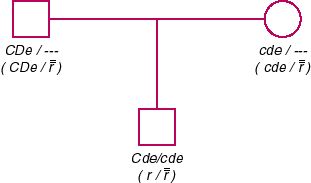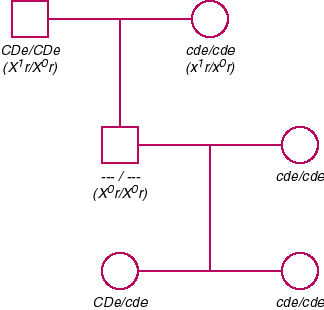

There are many advanced topics in the Rh system. Here we will preview one of the most unusual ones:
Rhnull red cells (designated ---/---) are extremely rare cells that lack all Rh antigens. Persons with this phenotype often result from consanguineous matings since both parents have an extremely rare gene, as discussed below.
Rhnull have two genetic pathways . The amorphic Rhnull phenotype results from inheriting two rare amorphic genes, designated r (Figure 5-5). In routine Rh typing, parents of the Rhnull person appear to be homozygous for Rh genes, yet give weaker reactions with Rh typing sera than would be expected.

A regulator (suppressor-type) Rhnull results from inheriting two rare suppressor (Xor) genes, instead of normal (X1r) genes, at a different locus from the CDE genes. As a result the Rh genes have no precursor substance to convert to CDE antigens. Even though such people cannot product Rh antigens, they can transmit Rh genes to offspring (Figure 5-6). In this example, the Rhnull propositus has inherited the Rh genotype (CDe/cde) and has transmitted these genes to offspring.

Rhnull persons have a mild, compensated hemolytic anemia known as Rhnull syndrome. The anemia is characterized by a slightly decreased hemoglobin and hematocrit and the presence of stomatocytes.
Because of the rarity of this phenotype (just over 40 Rhnull individuals are known to exist worldwide), it is highly unlikely that it will be encountered in routine transfusion services. Note, however, that immunized Rhnull persons may make single Rh alloantibodies (e.g., anti-e) or an antibody that reacts with all normal red cells (except Rhnull cells), which is designated anti-Rh29 in the numerical nomenclature.

| Advanced Topics | 
|